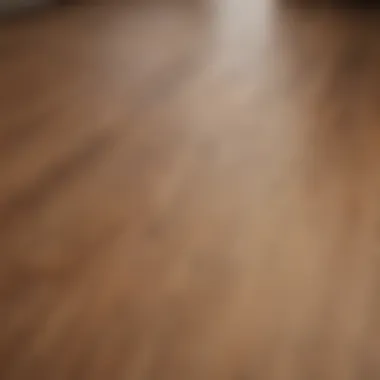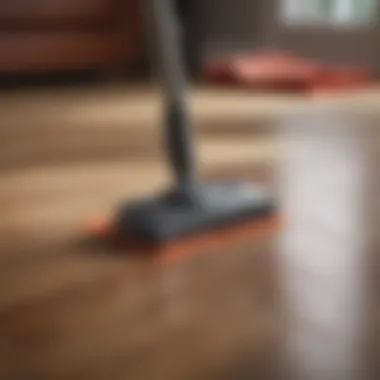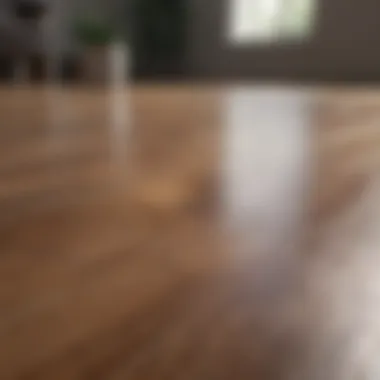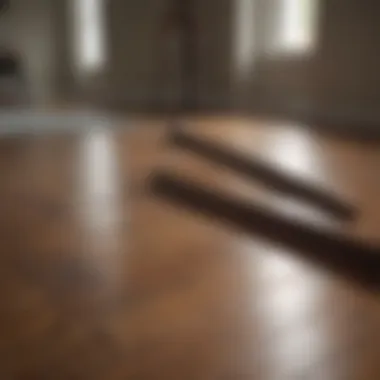Deep Cleaning Laminate Flooring: Your Complete Guide


Intro
Deep cleaning laminate flooring isn't just about making it look good; it's about maintaining a valuable asset in your home. Many people admire the aesthetics of laminate, often likening it to solid wood or tile as it can add significant character to any living space. However, because laminate is made from a mix of materials, it requires a specific approach for deep cleaning to avoid damage and to ensure longevity. Understanding the ins and outs of laminate flooring care ultimately turns your floor from merely functional to an elegant component of your home.
While cleaning may seem straightforward, the varying chemical responses between laminate floors and standard cleaning products can lead to unpleasant surprises. In this guide, you’ll uncover not just the how-tos, but the whys behind effective cleaning methods. From selecting the appropriate tools and solutions to understanding the right techniques, we'll break it down into actionable steps, ensuring your floors retain their sheen without compromising their structural integrity.
= "A clean home is a happy home. But when it comes to laminate, a little extra care goes a long way."
As we delve deeper, we’ll showcase homes that exemplify exquisite laminate flooring care, and discuss locations worldwide where such flooring shines brightly. Interior design trends and landscaping inspirations will tie together the aesthetic aspects of home decor, illustrating how deep cleaning links into broader home maintenance practices. Let’s get started!
Understanding Laminate Flooring
Understanding laminate flooring is crucial for anyone looking to deep clean their surfaces effectively. It’s not just about the cleaning, but also about knowing what you’re dealing with when tackling dirt and grime. This section breaks down the composition of laminate floors, dispels common misconceptions, and highlights the real benefits, making it easier to appreciate why deep cleaning is vital.
Composition of Laminate Floors
Laminate flooring is typically made up of several layers. The top layer, known as the wear layer, is designed to resist scratches and stains, which is one of its main attractions. Underneath, a design layer provides the aesthetic appearance, often mimicking wood or stone beautifully. Then comes a core layer made from high-density fiberboard (HDF), providing stability and strength. Finally, a backing layer acts as a moisture barrier and offers additional support.
Knowing the composition helps individuals to choose the right cleaning methods. Over time, dirt can accumulate in grooves or any scratches, potentially affecting the overall appearance. Careful maintenance can help in preserving the charm of laminate flooring.
Common Misconceptions
There are numerous misconceptions surrounding laminate flooring. A prevalent myth is that laminate cannot be cleaned with water. While excessive moisture can indeed cause damage, using a damp cloth or a microfiber mop is often perfectly acceptable. Another frequent belief is that laminate floors cannot be refinished. This is untrue, as some more modern laminate floors can be resurfaced, although it's not as common as with hardwood.
Not understanding these points might lead homeowners to avoid taking effective cleaning steps. They may wrongfully assume their flooring is too delicate or easy to ruin, which could hinder the cleaning process. Realizing the truth behind laminate flooring's durability can empower homeowners.
Benefits of Laminate Flooring
Laminate flooring offers a myriad of benefits. For starters, it is generally more affordable compared to hardwood or stone options, making it accessible for various budgets. It’s also highly versatile, available in an array of designs and finishes to suit different tastes and decor styles.
Moreover, laminate floors are incredibly low-maintenance, requiring significantly less upkeep than other flooring materials. They resist fading under sunlight, helping to maintain their color even after years of exposure.
Laminate flooring isn’t just easy on the wallet; it’s also easy to install, making it a popular choice for DIY enthusiasts.
In addition to all that, laminate is usually manufactured with environmental concerns in mind, using materials that have been sourced responsibly. This combination of affordability, aesthetic appeal, and environmental friendliness makes laminate a strong contender for many homeowners.
Understanding these elements of laminate flooring provides a solid foundation before approaching the more hands-on aspects of deep cleaning, allowing homeowners to tailor their strategies to suit their specific expectations and needs.
Preparing for Deep Cleaning
Deep cleaning laminate flooring is not just about grabbing a mop and a bucket; it requires a thoughtful approach. The significance of this stage can’t be emphasized enough. If you dive into cleaning without preparation, you might end up doing more harm than good. Consider this step like laying the groundwork before building a house — it sets the stage for everything that follows.
Taking time to assess what you're dealing with, gathering essential supplies, and laying out a plan not only makes the process smoother but also enhances the longevity of your flooring. This preparation phase can also save you from expensive repairs down the line, ensuring that your floors remain as stunning as the day they were installed.
Assessing Your Flooring Condition
Before you even think about breaking out the cleaning supplies, getting a good look at your laminate flooring is crucial. Walk through your home with a discerning eye. Look for scratches, dull spots, and stains. Noting these imperfections can help tailor your approach to cleaning.
Are there specific areas that require more attention? Perhaps the section near the door, where dirt is likely tracked in, is showing signs of wear. Taking stock of your flooring condition allows you to develop targeted cleaning strategies. After all, you wouldn't start fixing an engine without knowing exactly what's wrong with it, right?
Gathering Your Supplies
Cleaning Tools


Having the right cleaning tools can make all the difference. Consider a microfiber mop, renowned for its ability to trap dust and dirt without scratching your laminate. Its key characteristic is the fine fibers that pick up grime with ease. This tool's efficiency makes it a popular choice for deep cleaning, ensuring your floors shine without the risk of damage. It's also washable and reusable, which ultimately saves both money and time.
Another tool to include is a soft-bristle broom. Unlike a traditional broom, this one minimizes scratching while sweeping away debris. The unique feature of soft bristles offers versatility; it can gently clean corners and crevices without harshness.
Protective Gear
Protective gear isn't just about keeping you safe; it's about maintaining the beauty of your laminate flooring. Wear knee pads, for instance. They might look trivial, but they prevent knee strain when you're scrubbing or inspecting those hard-to-reach spots. What sets knee pads apart is their protective cushioning, making what could be an uncomfortable job far more manageable.
Additionally, using gloves is essential, especially if your cleaning solution contains any harsh chemicals. While some may argue they’re not necessary, feeling those chemicals on your skin is an unnecessary risk. The benefit of gloves is clear; they preserve your skin while allowing you to clean effectively without worry.
Cleaning Solutions
Next up is selecting your cleaning solutions. Here, an all-purpose cleaner specifically formulated for laminate flooring is invaluable. What makes these solutions conducive to the task is their gentle yet effective cleaning ability — they break down grime without harsh abrasives that can ruin your flooring. Additionally, they often come with a pleasant scent, combating unpleasant odors.
When choosing your cleaning solution, read the label carefully. Some products may contain solvents that can cause issues with your resin-coated floors. Opting for brands that emphasize safety and efficacy will lead to a successful cleaning experience, while cutting corners with random cheap options may lead to regrets later on.
Creating a Cleaning Plan
A cleaning plan acts as your roadmap. Without one, you may find yourself cleaning in circles, missing important moves or skipping steps entirely. Begin by determining which areas require the most attention and prioritize them. For instance, high-traffic zones demand more frequent cleaning than less-used rooms.
In addition, plan your cleaning schedule. Will you tackle the chore on weekends or in shorter weekday sessions? Sticking to a timeline ensures you don’t postpone to another day, which often translates to neglect.
Break your cleaning tasks into manageable chunks. For example, one day might focus on dry cleaning while another emphasizes wet cleaning.
Proper preparation sets a solid foundation for your deep cleaning adventure. It's about understanding your environment and equipping yourself with the tools and knowledge necessary for a successful, thorough clean.
Cleaning Techniques
Understanding the proper cleaning techniques for laminate flooring is paramount for preserving its integrity and enhancing its appearance. When done right, these methods can significantly extend the longevity of your floors while maintaining their shine and allure. Cleaning laminate involves not just the removal of dirt and grime but also taking precautions so the surface is not damaged. There are several approaches to deep cleaning, two primary ones being dry and wet techniques, both of which have their own unique characteristics and advantages.
Dry Cleaning Method
Using a Microfiber Mop
Using a microfiber mop is a cornerstone of any effective dry cleaning method for laminate flooring. Microfiber mops are particularly popular becuase they are gentle yet effective at capturing dust and dirt, without risking scratches on the surface. A key characteristic of these mops is their ability to attract particles and hold them, making it less likely that you’ll just push dirt around.
One unique feature of microfiber mops is their split fibers, which create a large surface area that clings to debris. This ensures a thorough clean without the need for excessive chemicals, which can harm laminate. On the downside, if your floors are heavily soiled, a dry mop alone may not suffice to restore their former shine.
Frequency Recommendations
Frequency of using the dry cleaning method is vital to maintain your laminate floors effectively. Ideally, a quick dry clean with a microfiber mop should be done weekly, if not more often. This routine prevents dirt buildup and keeps the laminate looking its best.
A unique aspect of frequency recommendations is that they consider foot traffic levels in your home. Higher foot traffic areas, such as hallways or living rooms, may require more frequent cleaning. While regular dry cleaning is beneficial, it shouldn't replace deep cleaning methods every so often, as a balance is key to full maintenance.
Wet Cleaning Method
Choosing the Right Cleaner
When it comes to cleaning laminate floors, selecting the right cleaner can make or break your efforts. An appropriate cleaner is one that won't leave a residue or warp the laminate. Many enthusiasts lean toward pH-balanced, non-abrasive solutions for this task.
Having a suitable cleaner allows homeowners to effectively address grime and stains while still being safe for the flooring material. However, knowing the right products might require some trial and error, as an incompatible solution can cause discoloration.


Application Techniques
The application of the chosen cleaner plays a crucial role in achieving the desired cleanliness without damaging the surface. The best approach is to apply the cleaner with a lightly moistened mop rather than soaking the floor. This method limits moisture exposure, which is detrimental to laminate flooring.
Employing this technique helps prepare the floor for an effective clean, minimizing the risk of water damage. Using circular motions when cleaning can also help ensure that the solution is evenly distributed, leading to a consistent finish. On the downside, if not done with care, improper application can leave streaks or excess moisture, which are unsightly.
Spot Cleaning
Identifying Stains
Identifying stains accurately is the first step towards maintaining pristine laminate floors. Stains can vary significantly—from food spills to pet accidents, and recognizing their nature helps in deciding the proper cleaning method to employ. Common stains include those from wine, ink, or oil.
Most homeowners benefit from understanding different stain characteristics, as a hasty approach can lead to further damage. Therefore, diligence in identifying the type of stain enables you to choose the correct cleaning solution.
Appropriate Spot Treatment
Once stains have been identified, the next logical step is appropriate spot treatment. This ensures that targeted cleaning is effective without affecting the rest of the laminate flooring. Using soft cloths or cotton balls with compatible cleaning solutions helps negate the risk of spreading the stain.
This targeted approach is efficient as it allows for direct action without the need to go through a full cleaning cycle. Despite its advantages, failure to treat stains promptly can lead them to set into the surface, making removal significantly more difficult later on.
Remember, the sooner you address stains, the more likely you are to succeed in completely eliminating them!
By understanding these cleaning techniques and their respective roles within the broader context of laminate care, homeowners can take a proactive stance in maintaining the beauty and durability of their floors.
Post-Cleaning Care
After embarking on the journey of deep cleaning your laminate flooring, it’s easy to think that the task is behind you. However, what you do next can significantly impact the longevity and aesthetic appeal of your floors. This section emphasizes the importance of post-cleaning care, including inspecting the floors for any imperfections and adopting preventive measures to maintain their pristine condition.
Inspecting the Floors
Once you’ve finished cleaning, take a moment to inspect your floors. This straightforward step is crucial. Look for any leftover residue, potential scratches, or spots that you may have missed. A thorough inspection can reveal hidden issues that require attention.
It’s wise to check for:
- Scratches: These may have gone unnoticed during cleaning. Take note of their locations and severity.
- Stains: Sometimes, stains that were previously invisible may become apparent after cleaning. Keep an eye on those areas.
- Moisture: Particularly after a wet cleaning method, ensure there’s no lingering moisture. Prolonged exposure can lead to warping.
If any issues are found, address them immediately. Remember, a little attention now can save you a heap of trouble later.
Preventive Measures
Taking preventive measures is a proactive approach in maintaining your laminate flooring, ensuring it remains as appealing as the day it was installed. These actions can help you avoid extensive future cleaning and repairs.
Regular Maintenance Tips
Regular maintenance emphasizes the importance of consistency—this isn’t just a one-off chore. Establishing a routine can dramatically enhance the longevity of laminate floors. Here’s why it’s beneficial:
- Frequency: Aim to sweep or vacuum weekly to prevent dirt buildup that could scratch your floor. It only takes a few minutes and pays off in the long run.
- Cleaning Products: Use gentle cleaning solutions derived from natural ingredients. Harsh chemicals can strip the shine and integrity of your flooring.
One unique feature of these regular maintenance strategies is their cost-effectiveness. You don’t need expensive cleaners or complicated methods, just a bit of time invested regularly.
Use of Area Rugs


Area rugs can be an invaluable asset for your laminate flooring. They not only enhance the decor but also serve as a protective layer. Their key characteristic lies in their ability to:
- Prevent Damage: Rugs shield high-traffic areas from wear and scratches.
- Easy Maintenance: They can be easily washable, making it simple to maintain cleanliness across the area.
However, it's important to choose the right rugs. Avoid rubber-back or latex mats, as they can trap moisture underneath, potentially leading to damage. The unique feature of area rugs is that they can provide style and functionality in one go, making them a popular choice for homeowners.
By integrating post-cleaning care and preventive measures, you’re not just preserving the beauty of your laminate flooring; you're also extending its life and ensuring it remains a source of pride in your home.
Troubleshooting Cleaning Issues
When it comes to maintaining laminate flooring, understanding troubleshooting is not just an edge; it’s essential. Scratches and stains can appear out of nowhere, leaving homeowners feeling defeated. Tackling these issues head-on ensures the floors remain appealing and functional.
Deep cleaning isn’t merely about a surface shine—it's about preserving the life of your laminate. Addressing these common dilemmas not only keeps the floors looking their best but also spares you from costly repairs or replacements down the line.
Dealing with Scratches
Scratches can be as bothersome as a persistent itch. Over time, your laminate might endure wear and tear, revealing unsightly marks that detract from its smooth finish. While minor scratches may seem harmless, left untreated they can worsen.
Here’s how to handle them:
- Identify the Scratch Type: Is it superficial or deep? Oftentimes, light scratches can be tackled with a simple polishing kit specifically designed for laminate flooring.
- Use a Repair Kit: These kits often include colored markers or putties. Carefully apply the color to the scratch and blend it in using a soft cloth to achieve a seamless look.
- For Deeper Scratches: You might want to dab at the scratch gently with fine-grit sandpaper followed by a laminate repair paste. This might not completely erase the scratch, but it can significantly reduce its visibility.
"While scratches may feel like the end of the world, a little patience and the right approach can bring floors back to life."
Resolving Stubborn Stains
Stubborn stains can be a puzzle that leaves many households frustrated. You might spill a cup of coffee or wine—accidents happen, but handling these mishaps effectively is crucial. Here’s what to consider:
- Act Quickly: The sooner you intervene, the less likely a stain will settle. Blot the area rather than rubbing it, as this can spread the stain further.
- Select Appropriate Cleaners: Always check to see that the cleaner is suitable for laminate flooring. A mixture of water with a mild dish soap works wonders for many stains. For tougher spots, consider a dedicated laminate cleaner.
- Use a Soft Cloth or Sponge: Avoid abrasive tools that can damage the surface. Gently using a cloth ensures you don't worsen an already tricky situation.
- Citrus cleaners can also combat grease stains. They’re harmless on laminate, but effective for breaking down tough spots.
- For Persistent Stains: You could make a paste of baking soda and water. Apply it to the stain and let it sit for a bit before rinsing with water.
Handling scratches and stubborn stains with confidence can turn potential headaches into mere blips on the radar, helping to keep your laminate flooring looking pristine.
Ultimately, maintaining the charm of your laminate flooring involves a proactive approach. With a clear understanding of troubleshooting, you can swiftly bring back the beauty and enjoy an aesthetically pleasing space.
Closure and Best Practices
In wrapping up our guide, it’s crucial to understand that deep cleaning laminate flooring isn’t just about clearing away dust and grime. Approaching this task thoughtfully can significantly extend the life and beauty of your floors. A clean laminate surface not only enhances the overall aesthetic of your home but also plays a role in maintaining a healthy living environment.
The methods and techniques discussed throughout this article are aimed at reinforcing the foundational care of your laminate floors. By adopting the right practices, you can avoid common pitfalls that might lead to premature wear and tear.
"A little preventive care goes a long way, keeping your laminate looking as fresh as the day it was installed."
Summarizing Key Techniques
To ensure long-lasting results, implement these key techniques:
- Regular Dry Cleaning: Use a microfiber mop consistently to trap dust and prevent scratches.
- Strategic Wet Cleaning: Opt for a well-diluted cleaner specially formulated for laminate. Spotlight spots rather than soaking the entire floor with water.
- Prompt Spot Treatment: Address spills and stains as soon as they happen to minimize damage and staining risks.
- Routine Inspections: Make a habit of checking for scratches, discoloration, or other damage regularly, allowing for timely repairs.
By integrating these practices, maintaining your laminate flooring can be a straightforward endeavor. The essence lies in consistency—long-term care often yields exponential benefits compared to sporadic deep cleaning.
Establishing a Routine
Crafting a cleaning routine tailored for your specific laminate flooring needs is invaluable. Here’s how you can set up an effective, easy-to-follow plan:
- Weekly Cleaning Schedule: Make a commitment to dry mop your floors at least once a week. Setting aside this time can substantially reduce built-up dirt and dust.
- Monthly Deep Cleaning: Dedicate one day each month for a more thorough cleaning, which includes wet cleaning and spot treatments.
- Seasonal Inspections: Every few months, check for any larger issues like scratches or warped sections, addressing these before they escalate into bigger repairs.
- Mindful Adjustments: Consult your flooring’s manufacturer guidelines to adjust your cleaning methods based on your laminate type. If you notice specific weaknesses in your flooring, adjust your routine accordingly.
By establishing this routine and treating your laminate flooring with the respect it deserves, you are not only preserving its beauty, but you’re also safeguarding your investment in your home. Proper care, guided by these best practices, reinforces the notion that laminate flooring can be both durable and stunning long into the future.







